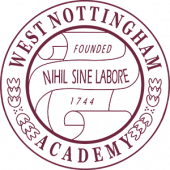Col. Richard R. Hallock ’37 – A Legacy of Service
Other Blogs
- Joseph T. Richards: Laying
- Service Above Self: Teacher and
- My Four Year WNA Experience
- Col. Richard R. Hallock ’37 – A Legacy of Service
- Traveling Again
- “Nothing Without Work”
- Marathoning March
- Press Release: New Academic Program
- Instructions for accessing MySchoolApp
- WNA Launches Center for Creative Exploration
In May of 2001, Mrs. Richard R. (Myriam) Hallock presented West Nottingham Academy with an extensive collection of papers, medals, and other memorabilia from the military career of her recently deceased husband, Col. Richard R. Hallock, WNA class of 1937. Since that time, it has been my privilege not just to assemble and display these materials, but to build on them by researching the storied career of Col. Hallock. His story began in Oxford, PA, was nurtured in the classrooms of WNA, and eventually included chapters in places like war-torn Europe, post-WWII Berlin, Korea, and the Middle East. Along the way, he earned an impressive array of medals and other awards, risked his life for what he believed in, and ultimately risked his career for the same reason. He is a hero, not just in the usual military sense, but in his willingness to stand by his beliefs—even at the cost of some of his dreams. His experiences serve as a reminder to our students that honor and faith in the truth are not empty ideals, but part and parcel of their legacy as modern-day Rams.
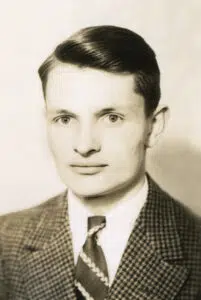
In 1935, young Dick Hallock joined the WNA community at the urging of his grandfather, a Presbyterian minister, who saw his potential and wanted him to get the best education he could. He did not waste the opportunity, graduating in 1937 as Valedictorian of his class, offering as his Valedictory address an assessment of “The Versatility of Goethe.” As hard as he worked to achieve this honor, however, Dick Hallock was not just a “dull boy” as he played on the football team and even performed the role of Dr. A.S. Trologer in the Senior Play of 1937. By the way, football was a pretty different animal back then, too. Hallock was 5’7” and 130 pounds when he went in the Army, so if he survived on the high school gridiron, it was a mark of his toughness and tenacity, not sheer size!
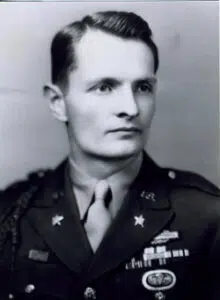
From WNA, Hallock went on to Oberlin College, graduating in 1941, just in time for World War II. He enlisted in the U.S. Army, completed Airborne training and Officer Candidate School at Ft. Benning, GA and then reported for duty as a platoon leader with the 551st Parachute Infantry Battalion. After vicious combat in Italy, his unit jumped into France as part of Operation Anvil Dragoon, fighting their way through the Alps and into Germany. At one point in this campaign, Hallock earned the Purple Heart, carrying an Austrian bullet in his leg for the rest of his life. For the record, this wasn’t because the Army wouldn’t operate to take the bullet out, he simply decided to leave the hospital and work his way back to his unit once it was treated sufficiently to let him go back to work.
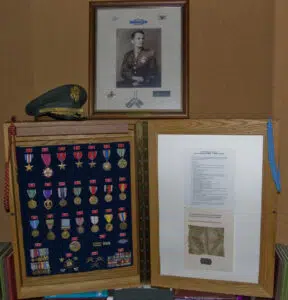
Other medals he earned in WWII include multiple Bronze Stars for valor and the Silver Star for leading his platoon in holding off an intense German attack. Though the award did not exist at that time, he was posthumously awarded the POW medal for being taken prisoner in 1945. The striking part of this story is not the capture itself, though when faced with the inevitable, he did manage to negotiate the freedom of the women and children in the house in which his platoon was trapped. The telling moment came as he and his men were being transported in German trucks along with other American POWs when Allied aircraft attacked the convoy. Seizing the opportunity, Hallock led an escape and returned to his unit with such detailed intelligence on German placements that his superiors recognized the future he had in intelligence and leadership in the U.S. Army. This recognition led to his selection by General Lucius Clay, the Military Governor of occupied Germany, to serve as his Personal Aide for Intelligence in post-war Berlin. In this position, Hallock played an important role in major Cold War events, including the Berlin Blockade and Airlift. General Clay later referred to him as “one of the finest soldiers I know.” At this point, (then) Captain Hallock realized he had a future in the U.S. Army, so he made it his career.
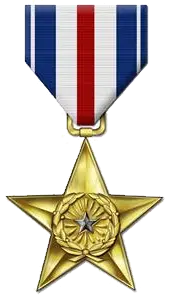
Hallock achieved the next milestone in his career in Korea, where he was the youngest battalion commander in that conflict. Some of the medals he earned there reflect both the kind of leader he was and the unusually multi-national character of that war. One early award was yet another Bronze Star for valor. As quoted in the award order itself, Maj. Hallock was “coordinating fire support” and making “frequent trips to an outpost 100 yards away.” This outpost then “took a direct hit” and he was “blown through the rear door.” At this point, rather than run for cover, he “assisted in getting aid for the wounded” and “moved to an adjacent hill and continued directing fire from that point.” In another instance, when Major Hallock was informed that one of his patrols was lost, he grabbed an observation plane and went looking for them. The plane was hit by enemy fire several times, but fortunately, Hallock was not. (The patrol was eventually found.) For this action, he received the Air Medal, not often awarded to infantry commanders. The most intriguing medal in this collection, however, was not awarded by the United States, but by the government of Ethiopia. Organization and logistics were always strong suits for Maj. Hallock as was coordinated with other units and he generously shared those skills with the Kagnew Battalions, Ethiopia’s contribution to the UN forces in Korea. For this assistance, the Ethiopian government awarded him the Haile Selassie Medal with Palm Leaf, a rare honor for someone not a citizen of that nation. So, a West Nottingham kid from Pennsylvania gets a medal from the Ethiopian government in the midst of a war in Korea!
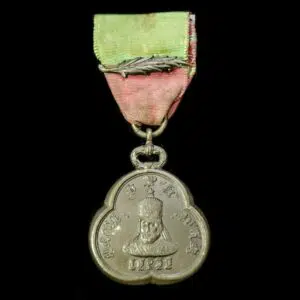
In the peace that followed the Korean War, Hallock’s was clearly a career on the rise. His assignments included a stint in Turkey with NATO and postings with both the Chief of Staff of the Army and the Secretary of Defense. As the Vietnam War escalated, he was primed for a brigade command and the star that came with it, until his integrity regarding the Army’s latest infantry rifle, the M-16, got in the way. Long story short, the M-16 was a lighter, smaller caliber weapon that was easier for troops to carry and use and which produced excellent results in testing and in the field—when it was used and cared for properly. The problem was that a number of manufacturers were heavily invested in the larger caliber round used by the M-14, the standard issue rifle for the U.S. Army at that point. Their fear of lost revenues, coupled with an inherent resistance to change in many senior military minds, led the Army to insist on technical changes that hampered the M-16’s effectiveness in the field, impairing the ability of American soldiers to defend themselves and even costing lives in combat. Now stateside, Colonel Hallock conducted a wide-ranging series of tests on the M-16, demonstrating that it was those changes, not the design of the weapon itself, which caused these casualties. Using this evidence, a Congressional investigation, the Ichord Hearings, found the Army’s actions “bordered on criminal negligence.” Because of his studies and persistence, the modifications were changed again, and the M-16, in various forms, remained the basic infantry weapon for our military until its recent replacement by the M4.
Standing up against the military and defense procurement establishment is never a good career move, but Hallock did what he knew was right. He also knew the cost, so in 1967 he retired from the U.S. Army and went to work in a variety of civilian capacities. He was quickly hired by the Bureau of the Budget, where he worked with systems analysis people in Defense Secretary McNamara’s legendary “Whiz Kids.” From there, he went to the Rand Corporation, working as a consultant on projects around the world. Eventually, Hallock figured out that he could do this kind of work just as well on his own, so he retired from government service to form his own very successful consulting company, Intrec.
Throughout his storied career, Hallock never forgot the lessons he learned while a student at West Nottingham Academy. He often credited our school with helping to shape him into the man he became, “West Nottingham gave me the underpinning of values and scholarship that carried me through the remainder of my life.” A generous supporter of the school, he kick-started a new endowment in the late ’90s with WNA’s first million-dollar gift. As President of the Board of Trustees, he created the Academy’s first Strategic Plan and continued to give generously of his time, wisdom, and financial support until his passing from cancer in 1999. Since then, his devoted widow, Myriam Hallock, has honored his legacy with continued contributions to help the school grow and achieve Dick’s vision for its future. Even more important than these gifts, however, are the standards Richard R. Hallock ’37 set for courage, integrity, honor, and commitment to one’s values, standards which serve as examples for our students today and which will continue to do so for years and years to come.
Author Rusty Eder is the History Department Chair and School Historian.
Opportunity awaits you at West Nottingham Academy!
Every day, in every activity, from the classroom to the playing fields, art studios, and club gatherings, students are exposed to a diverse community of learners from all walks of life.
